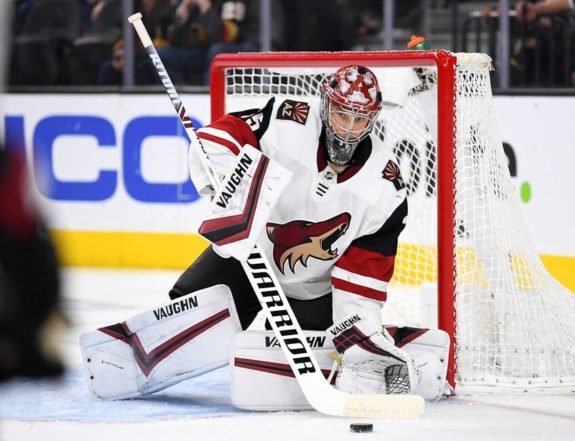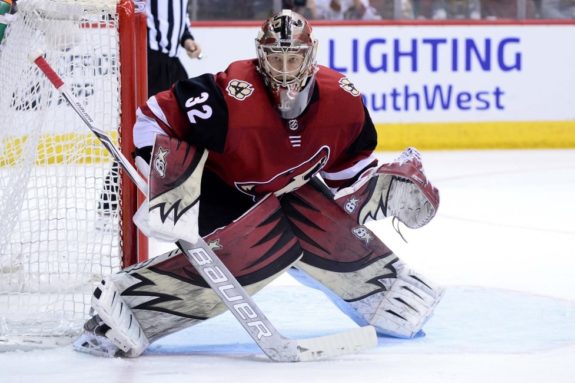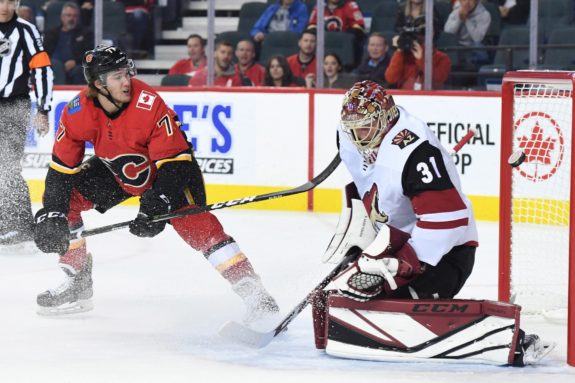Arizona Coyotes goalie Antti Raanta may have just made his first start in almost a single calendar year, but the good news has prompted more questions than answers.
Raanta vs. Kuemper vs. Comrie
Raanta’s return has helped the Coyotes prove the impossible: Their future in net is both bright and murky all at once, without a clear No. 1 goalie. Not only that, but, for the moment, they don’t even have two goalies. They’ve got three, with Darcy Kuemper and Eric Comrie also on the roster right now. If this were multiple choice, good luck.
The Coyotes ultimately did not make the playoffs last season and they’ll be hard-pressed to do so in 2020. However, that has more to do with the competition in the Pacific Division and Western Conference than it does with the talent on the roster, specifically in net. For example, it would be hard to blame the Coyotes’ goaltending for the lack of playoff appearances. Just look to career-backup Kuemper. He may have a modest 1-2 record so far, but he’s earned a 1.36 goals-against average and .957 save percentage in the process.

Kuemper’s statistical success so far is simply an extension of last year’s when he posted a career-best 27 wins (27-20-8) with a 2.33 GAA and .925 save percentage. His performance down the stretch as the defunct No. 1 earned him a two-year, $9 million extension that goes into effect starting in 2020-21.
Who’s the No. 1? Raanta or Kuemper
The $4.5 million cap hit is an interesting twist. Incumbent Raanta’s deal, which ends in 2021, carries one of just $4.25 million, prompting the question: Just who is the starter? Kuemper admittedly looks to have the inside track, but Raanta was the guy not too long ago, and it’s not as if he stumbled as much as he has fallen victim to circumstance.

Raanta has generally been great in the games he’s gotten in as a Coyote since coming over in the Derek Stepan trade with the New York Rangers. However, those games have become increasingly few and far between. Raanta remains an injury concern, with just 59 appearances over the last two seasons, including just 12 in 2018-19. Hence Kuemper’s emergence.
Raanta just returned to the Coyotes following a conditioning stint in the minors, during which he posted a shutout. It’s encouraging, but, as simply the latest episode in the saga that is Raanta’s lengthy injury history, it along with his recent start doesn’t mean all that much. So, does that make Kuemper the go-to guy? Not necessarily due to several factors.
Firstly, the higher cap hit he was awarded is arguably just inflation at work, with Raanta having signed his deal a year and a half ago. General manager John Chayka could very well see both Kuemper and Raanta as equals and want to let them settle the goaltending controversy on their own, which is fine. The combined $8.75 million cap hit is theoretically manageable, seeing as two teams, the Montreal Canadiens and Florida Panthers, devote at least $10 million to each of their No.1 goalies (Carey Price and Sergei Bobrovsky) alone.
Secondly, were Chayka more committed to Kuemper than Raanta, the deal would be longer. You don’t give the goalie in whom you’re placing your faith regarding the long-term health of the organization a two-year term. Obviously, Kuemper deserves a show of loyalty for what he’s accomplished as a Coyote up to now. That’s what his new deal is though, as he’s 29 and had never been more than a backup. He’ll be getting a nice raise from the $2.1 million he’s making now. So, he’s likely content. He did sign on the dotted line after all.
Chayka’s Goaltending Dilemma
All that taken into consideration, it remains to be seen if Kuemper’s just a flash in the pan or not, all due respect to him. It’s possible he’s a late bloomer, but, by the time his new deal expires, he’ll be 32 and theoretically exiting his prime anyway, making it an incredibly team-friendly contract.
Chayka deserves some credit as a result. In spite of the fact the Coyotes are in a precarious salary cap position, they’re not overextended in net, which is key in an era during which average goaltending has generally been proven to be sufficient during the playoffs. It just so happens Raanta and Kuemper are above-average, which can only mean good things. It’s up to the team in front of them, though.
Even if neither stays on past their current deals, the net is theoretically in good hands. Tucson Roadrunners goalie Adin Hill has already established himself as a competent NHL goalie with an 8-8 record over the last two seasons. As a 23-year-old, he’ll likely only get better. Finally, after having claimed Comrie off waivers from the Winnipeg Jets, the Coyotes almost have an embarrassment of riches in net.

Granted, Comrie has yet to play for his new team due to visa issues and he has even less NHL experience than Hill despite being a year older. However, he’s a goalie the Coyotes have reportedly had an eye on for a while, and he comes complete with a new lease on his NHL career, even as mere backup.
While it’s uncommon for teams to carry three goalies, the Coyotes can seemingly make it work with just one extra defenseman and forward. A potentially serious Niklas Hjalmarsson injury complicates matters, but look for the Coyotes to choose between one of Kyle Capobianco and Ilya Lyubushkin to stay up, with the other destined for more reps in the American Hockey League to get more playing time.
The Coyotes’ Bright Future in Net
The same goes for Hill. He should stay in the AHL, where he is effectively guaranteed to be the No. 1 ahead of the likes of Erik Kallgren and Ivan Prosvetov, on the depth chart. They each serve as further proof the Coyotes are safe in net for the foreseeable future.

That’s in large part why Comrie and Comrie alone is a good insurance policy to have, with Raanta’s injury history being as extensive as it is. Seeing as Comrie’s waiver-eligible, his time has to be now. He’ll undoubtedly have to prove himself, as Raanta and Kuemper are the two likelier candidates to have to battle it out. However, if Comrie turns out to be a relatively late-bloomer like Kuemper, well, the crowded crease is a good problem to have.
There are few hypothetically unappealing outcomes here, as both Raanta and Kuemper have shown they can play at an elite level over an extended period of time. Realistically, either one of them can earn the No. 1 job at the other’s expense. Alternatively, they push each other to be better without anyone separating himself from the pack. It’s survival of the fittest at its finest. Granted, this is hockey and not evolutionary biology, but there aren’t any wrong answers here.